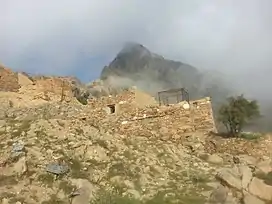Bareq
Bareq (Arabic: بارق; also transliterated as Bāriq), is one of the governorates of Asir in the north-west of the region, 120 km (75 mi) north of Abha. It occupies a distinct location midway between Tihama and Asir, 412 m (1,352 ft) above sea level. With an estimated population of 75,351, it is well off economically; the city has grown rapidly and has many government services and public utilities available. It is one of Asir's winter resorts because of its natural environment and mild winter weather. Bareq has valleys.
Bareq
بارق Bariq | |
|---|---|
Governorate | |
 Bareq Skyline | |
| Nickname: عروس المجد ("Bride of Glory") | |
 Bareq | |
| Coordinates: 18°55′56″N 41°56′38″E | |
| Country | |
| Province | Asir |
| Joined Saudi Arabia | 1925 |
| Founded by | Bariq tribe, of Azd |
| Government | |
| • Mayor | Ahmed Awad Al-Bariqi |
| • Governor | Yahya Abdulrahman |
| Elevation | 412 m (1,352 ft) |
| Population 2015 | |
| • Total | 75,351 |
| Time zone | UTC+3 (EAT) |
| • Summer (DST) | UTC+3 (EAT) |
History

Bareq was founded in 220 AD. (citation?) Bareq is part of the territory which is historically known as the "Yemen", which dates back to the second millennium BC and was inhabited by an immigrant tribe from Marib in Yemen called Bariq belonging to the ancient tribe of Al-Azd that has many clans linked to it.[1][2][3] Known before the advent of Islam as Diyār Bāriq, it was traversed by the ancient trade route from Yemen to Mecca and the Levant, known as the winter and summer journeys.[4][5] It also used to hold the Suq Hubasha[6] in the first eight days of the month of Rajab (other sources say three days).[7] The market and convoys were protected by the Bareq country and this souq was the market for Azd. It was one of the greatest Arab souqs of all, and also the last of the pre-Islamic markets to be destroyed.[8] In the mid-seventh century AD, the Bareq tribe entered Islam and played a pivotal and a major role in the Muslim conquests,[9][10][11][12][13][14] and many Bariqis settled in various countries after the Muslim conquest.[15][16][17]
Modern
At the rise of the First Saudi State in the 18th century, the villages of Bareq were governed by local clans in a fashion similar to that of Nejd, while the large tribal confederations maintained a high degree of autonomy. Bareq gave allegiance to First Saudi State in 1809 under the leadership of the Bareq chief Ahmed Ibn Zahir of the Humaydah clan.[18][19] When the First Saudi State was destroyed by the Egyptians in 1818, the Bariqis continued to fight the Egyptian forces in their region tenaciously. With the withdrawal of the Egyptians in 1840.[20]
In 1872 the Turks took direct control of the region, making Bareq a sanjak of Turkish Yemen, remained in the Ottoman Empire for 42 years.[21][22] In the 1880s, the Idrissi dynasty of Sabya became the predominant political force, ruling the region under the supervision of Turkish advisors. In the early twentieth century, in 1910, Muhammad ibn Ali al-Idrisi, a descendant of Ahmad Ibn Idris, began to establish political control of Bareq. After negotiations with Italy, which had interests nearby in Somalia, the Idrisi forces of Muhammad came into conflict with Ottoman forces in Ajama. The Idrisis were defeated in 1911 by Hashemite forces under Hussein ibn Ali, Sharif of Mecca,[23] then still loyal to the Ottomans, but the tide turned when Muhammad ibn Ali concluded a secret military alliance with Great Britain (by then at war with the Ottomans) in 1915, and Sharif Hussein later switched sides and joined the British against the Ottomans.[24]
Turkish troops were withdrawn following the outbreak of war in 1914, and Turkish rule in Bareq became even more tenuous. In April 1915, British agents, hoping to garner Bariqis support for the Allies, signed a treaty with the Idrisi emir guaranteeing the independence and security of Bareq upon the defeat of the Turks. Bariqi troops fought the Turks as allies of the British forces in January 1917;, in a subsequent agreement, the British government of India promised independence at the end of the war.
After the end of First World War, Muhammad ibn Ali became ruler of an internationally recognized sovereign state, until his death in 1920. The territories of the emirate reached from Bareq in the north to Hudaydah in the south. Muhammad's successors were however unable to resist the growing power of Abd Al-Aziz Ibn Saud, who began annexing south of Arabian Peninsula and its neighboring regions after Muhammad's death. The Saudis took Bareq in 1924,[25] and from then on Bareq was controlled by the House of Sa'ud - a situation formalized in 1934 with the signing of the Treaty of Taif between Saudi Arabia and Yemen..
Geography
Bariq is at an elevation of 412 m (1,352 ft) above sea level, and approximately 90 km (56 mi) inland from the Red Sea. It's lies 120 km (75 mi) km north-west of Abha (Occupying a distinct location at the road junction at the middle between Tihama and Asir). The district of Bariq begins about 10 miles (16 km) north of "Muha'il", and covers an area of about 40 miles (64 km) from north to south and 57 miles (92 km) from east to west, and are bounded by Tanomah to the east, Majaridah to the north, Muhail to the south, and Qunfudhah to the west.[26] It is a fertile country and well watered and extensively cultivated, maize, millet, barley, and sesame being the principal crops.[27][28]
Ethnography
The inhabitants of Bareq are largely made up of the Sunnis Saudi Arabians. There are also significant foreign populations, primarily from Asia, Turkey, and other Arab countries.
In Bareq & surrounding areas, a local dialect of Arabic is spoken, which is known as Bareqi Arabic (Arabic: لهجة بارقية, lahjat bariqia), spoken by some 60,000 people. It shares similarities with the Hejazi & Najdi dialects, as well as the Himyaritic language.
Agriculture
The region's crops, most of which are cultivated on small plains irrigated by the floods or on the silt of the stream beds. include wheat, coffee, indigo, ginger, vegetables, and sesame. It is one of the best agricultural districts in Saudi Arabia. The region also supports cattle, sheep, and goats.[29]
Education
The first school in Bareq was established in 1952. Today Bareq is home to more than 100 public educational institutes.
Climate
Bareq has an arid tropical climate with an average annual temperature of 86.5 °F (30.3 °C). January typically sees daytime highs of 82 °F (28 °C) and lows of 64 °F (18 °C), while July has average daytime highs of 92 °F (33 °C) and lows of 69 °F (21 °C). With an average annual temperature of 66.8 °F (19.3 °C).
| Climate data for Bareq, Saudi Arabia | |||||||||||||
|---|---|---|---|---|---|---|---|---|---|---|---|---|---|
| Month | Jan | Feb | Mar | Apr | May | Jun | Jul | Aug | Sep | Oct | Nov | Dec | Year |
| Average high °F (°C) | 82 (28) |
83 (28) |
84 (29) |
86 (30) |
86 (30) |
88 (31) |
92 (33) |
91 (33) |
90 (32) |
87 (31) |
86 (30) |
84 (29) |
87 (30) |
| Average low °F (°C) | 64 (18) |
66 (19) |
66 (19) |
67 (19) |
67 (19) |
68 (20) |
69 (21) |
69 (21) |
68 (20) |
67 (19) |
66 (19) |
65 (18) |
67 (19) |
| Source: .[30] | |||||||||||||
Cuisine
Bareq is known for its cuisine and traditional meals such as jalamah, khmer, haneeth, lahoh, murtabak, aerykh, asida, muqalqal, and mandi.
Hospitals and medical care
- Bareq Hospital
- Alahli Hospital
- Alsaqr dental
- Alamer Hospital
Notable people
Gallery
 Old houses of Atharb
Old houses of Atharb Downtown of Bareq
Downtown of Bareq
See also
References
- Ulrich, Brain John (2008). Constructing Al-Azd: Tribal Identity and Society in The Early Islamic Centuries. University of Wisconsin Madison,Wisconsin: c2008. p. 290. ISBN 9780549634430.
- Bahrain through the ages: the history،
- Excellence and precedence: medieval Islamic discourse on legitimate leadership،
- إيلاف قريش رحلة الشتاء و الصيف،
- Encyclopaedic Ethnography of Middle-East and Central Asia،
- Meccan trade and the rise of Islam p123،
- السلم عند العرب قبل الاسلام،
- Jerusalem Studies in Arabic and Islam Vol. 9 p33،
- Constructing Al-Azd: Tribal Identity and Society in the Early Islamic Centuries،
- History of al-Tabari Vol. 12, P10،
- Tabari, leiden, I,P2200,2218,2187,2196
- The Early Islamic Conquests. P169,167,200,205,209,211.
- The Challenge to the Empires P201,200 ،
- Book The Challenge to the Empires page 220،
- The Role of the Arab Tribes in the East During the Period of the Umayyads (40/660-132/749) P35,34 ،
- The Waning of the Umayyad Caliphate ،
- al-qabalīyah wa-atharuhā fī al-shiʻr al-Umawī،
- كتاب الدولة السعودية الأولى.
- كتاب جحيم الحكم السعودي ونيران الوهابية.
- Sibāʻī, A. (1999). Taʼrīkh Makkah: Dirāsāt fī al-siyāsah wa-al-ʻilm wa-al-ijtimāʻ wa-al-ʻumrān. al-Riyāḍ. OCLC 48048114.
{{cite book}}: CS1 maint: location missing publisher (link) - العلاقات بين مصر والحجاز ونجد في القرن 19،
- كتاب دراسات في تاريخ العرب الحديث.
- Barakātī, S. A.-M (2001). al-Riḥlah al-Yamanīyah. Cairo. OCLC 45920798.
{{cite book}}: CS1 maint: location missing publisher (link) - موجز تاريخ وأحوال عسير 1215 - 1341هـ،
- السراج المنير في سيرة امراء عسير.
- al-Bariqi, Mahmood Aal-Shobaily (2001). Al-Shariq: fi tarikh wa jughrāfīat bilād Bāriq. Maktabat al-Malik Fahd al-Wataniyah. p. 279. ISBN 9960-39969-9.
- Gazetteer of Arabia: A Geographical and Tribal History of the Arabian Peninsula: page 294،
- Asir Before World War I: A Handbook: page 51،
- Asir before World War I: a handbook P17,51.
- worldweatheronline.
